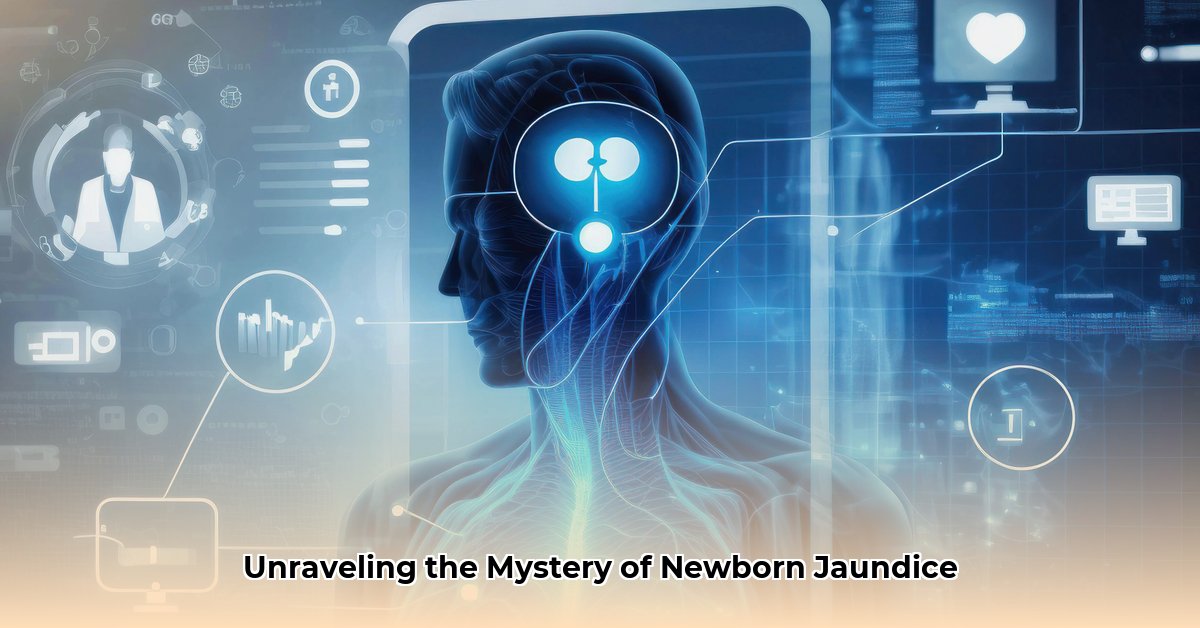Neonatal jaundice is a common condition affecting newborns, characterized by a yellowish discoloration of the skin and eyes. While often harmless and temporary, it’s crucial to understand the causes, diagnosis, and management of jaundice to ensure the well-being of newborns. This article provides a detailed overview of neonatal jaundice, drawing on insights from medical journals and offering practical guidance for healthcare providers and caregivers. For more on TcB devices, see these reviews.
Neonatal Jaundice: Understanding Bilirubin Levels and Types
Neonatal jaundice, the yellowish tinge in a newborn’s skin, affects approximately 60% of full-term babies and 80% of premature infants within their first week. It’s essential to recognize that jaundice isn’t a disease itself but a symptom indicating an underlying issue. Its presence signals the need to determine the root cause.
Jaundice occurs due to elevated levels of bilirubin in the blood, a condition known as hyperbilirubinemia. Bilirubin is a yellow pigment produced during the normal breakdown of red blood cells. In newborns, bilirubin production is often higher, and the liver, responsible for processing bilirubin, may not be fully mature.
Bilirubin exists in two primary forms: unconjugated (indirect) and conjugated (direct). Unconjugated bilirubin is not water-soluble and needs to be processed by the liver to be eliminated from the body. Elevated levels of direct bilirubin always warrant further investigation, as they indicate an underlying problem, such as liver disease or biliary obstruction.
Accurate bilirubin measurement is vital for diagnosing and managing neonatal jaundice. Various methods exist for measuring bilirubin levels, including:
- Transcutaneous Bilirubinometry (TcB): A non-invasive method that measures bilirubin levels through the skin using a handheld device.
- Total Serum Bilirubin (TSB): A blood test that measures the total amount of bilirubin in the blood.
- Smartphone Apps: Emerging technologies using smartphone cameras to estimate bilirubin levels.
Each method has its advantages and limitations in terms of accuracy, cost, and accessibility. Skin tests can be affected by skin color, a factor researchers are actively addressing to improve accuracy across diverse populations.
Treatment strategies for neonatal jaundice depend on the type and severity of hyperbilirubinemia. Unconjugated hyperbilirubinemia (UHB), the most common type, is typically treated with phototherapy, which uses special lights to help break down bilirubin in the skin. In severe cases, a blood exchange transfusion may be necessary. Intravenous immunoglobulin (IVIG) may also be used in certain situations. Conjugated hyperbilirubinemia (CHB) is always considered pathological, often requiring specific treatment for the underlying medical condition.
The American Academy of Pediatrics (AAP) updated its guidelines for managing neonatal jaundice in 2022. These updated guidelines emphasize personalized assessment and eliminate race as a risk factor, promoting individualized care based on each infant’s unique needs.
Access to reliable testing remains a significant challenge, particularly in underserved areas. Developing affordable, accurate, and user-friendly diagnostic methods is critical for ensuring timely intervention and preventing severe complications. Ongoing research focuses on creating innovative solutions to address this need.
Here’s a breakdown of how different stakeholders can contribute to improving jaundice care:
| Stakeholder | Actions | Goals |
|---|---|---|
| Healthcare Providers | – Implement the updated AAP guidelines. – Use point-of-care testing when available. – Ensure ongoing staff training. | – Establish consistent jaundice management protocols. – Invest in affordable diagnostic technologies. – Enhance education and data collection. |
| Public Health Systems | – Improve access to testing and phototherapy. – Conduct public awareness. | – Fund research into affordable technologies. – Establish reliable data tracking methods. |
| Parents/Caregivers | – Recognize jaundice symptoms. – Seek prompt medical attention. | – Participate in community education programs. – Utilize available online resources. |
| Researchers/Industry | – Develop affordable and reliable diagnostic tests. – Refine phototherapy. | – Design accurate and user-friendly tests. – Improve treatment options. |
Disclaimer: The content provided is intended for informational purposes only and should not be considered as a substitute for professional medical advice. Always consult with a qualified healthcare provider for any health concerns or before making any decisions related to your health or treatment.
Continued research and education are essential for advancing our understanding of neonatal jaundice and optimizing care for newborns.
Diagnosing Neonatal Jaundice in Dark-Skinned Babies: Early Detection Methods
Key Takeaways:
- Visual assessment alone is insufficient for detecting jaundice in dark-skinned newborns.
- Point-of-care testing (POCT) offers a practical solution for accurate diagnosis.
- Early detection is critical to prevent severe complications like kernicterus.
The Challenge of Visual Assessment
The accurate diagnosis of neonatal jaundice in newborns with darker skin tones can be difficult. The subtle yellowing of the skin and sclera, typical indicators of jaundice, may not be easily visible due to the increased pigmentation. This can lead to delayed diagnosis and potential complications.
Expanding Diagnostic Tools Beyond Visual Assessment
To overcome the limitations of visual assessment, alternative diagnostic methods are crucial:
- Point-of-Care Testing (POCT): POCT offers convenient and rapid assessment of bilirubin levels.
- Urine and Stool Analysis: Analyzing urine and stool samples for abnormal color or bilirubin content can provide valuable information.
- Stool Color Chart: A simple stool color chart can serve as a visual aid for detecting elevated bilirubin levels in stool.
- Transcutaneous Bilirubinometry (TcB): TcB is a non-invasive technique that measures bilirubin levels through the skin. TcB provides immediate results, enabling timely intervention.
Steps to Improve Diagnosis
- Comprehensive Assessment: Conduct a thorough examination of the newborn, paying attention to factors beyond skin and sclera color.
- Stool and Urine Analysis: Assess stool color and urine for abnormal signs. A simple stool color chart is a valuable tool.
- Transcutaneous Bilirubinometry (TcB): TcB offers quick, non-invasive bilirubin level measurement.
- Serum Bilirubin Measurement: If uncertainty persists after initial POCT, laboratory blood tests should be performed, which is considered the gold standard.
- Follow-up and Monitoring: Closely monitor the infant and repeat testing as needed, ensuring timely intervention.
Enhancing Healthcare Professional Training
Comprehensive training for healthcare professionals is crucial for improving the recognition of jaundice in all newborns, regardless of skin tone. Training programs should emphasize alternative diagnostic methods. A national image bank depicting jaundice in various skin tones can be a valuable aid.
The Role of Patient Education
Patient education is also essential for promoting early detection. Culturally sensitive educational materials should be provided to parents, teaching them how to recognize the subtle signs of jaundice. A proactive approach, providing information on how to monitor their baby can encourage early consultation.
Conclusion: A Collaborative Effort
Improving the diagnosis of neonatal jaundice in dark-skinned babies requires a multi-faceted approach. Enhanced training, access to POCT, and targeted patient education are vital. Collaborative efforts among healthcare providers, parents, and community organizations are essential to eliminating these disparities.
Neonatal Jaundice Management in Low-Resource Settings: Challenges and Innovations
Key Takeaways:
- Visual assessment is inadequate in low-resource settings (LRS), leading to delayed or missed treatment.
- Point-of-care (POC) devices offer a good solution for quicker diagnosis.
- Smartphone apps show potential but need further validation, especially for diverse skin tones.
Diagnosing Jaundice in LRS
Accurate diagnosis of neonatal jaundice is crucial, as untreated hyperbilirubinemia can have severe consequences. In LRS, limitations often hinder accurate diagnosis. Traditional methods, such as visual inspection, are unreliable because skin tone variations and poor lighting conditions make accurate assessment challenging.
Point-of-Care (POC) Devices: A Rapid Response
Several POC devices, offer quick and precise measurements of bilirubin levels. These devices represent a significant step forward in jaundice management in LRS. However, POC testing is not a perfect solution. Cost, maintenance requirements, and the need for trained personnel can limit their widespread adoption.
Smartphone Apps: A Promising Innovation
Smartphone apps are emerging as potential tools for jaundice screening. These apps use the smartphone’s camera to estimate bilirubin levels based on skin color analysis. However, these apps remain unvalidated, and their accuracy may be influenced by skin tone and lighting conditions. Rigorous clinical validation is needed before these apps can be widely used.
Key Challenges
- Limited Resources: Shortages of equipment, trained personnel, and financial resources hinder effective jaundice management in LRS.
- Accessibility: Many LRS lack access to specialized care, such as phototherapy and exchange transfusions.
*
- Water Mill Electricity Generator Provides Free Home Power - December 16, 2025
- Water Wheel Electric Generator Provides Free Home Electricity - December 15, 2025
- Choosing the Right Portable Hydro Turbine for Your Needs - December 14, 2025















